Convertkit Vs Leadpages 2024: Which Is The Better Choice?
Introduction:
In this article, we’ll compare two popular marketing tools: ConvertKit vs Leadpages. When choosing the right marketing tool for your business, the decision can be tough. With so many options available, it can be hard to know which one is the best fit for your needs. We’ll look closer at their features, pricing, and overall value to help you make an informed decision.
ConvertKit and Leadpages are reputable marketing tools but have distinct features and benefits. ConvertKit offers a comprehensive marketing software solution with advanced email marketing and automation capabilities, while Leadpages specializes in creating landing pages with additional lead-generation features. In the next sections, we’ll explore the details of each tool to help you decide which one suits your business needs better.
Key Takeaways:
Your business demands and objectives will determine the better marketing tools for your business between Convertkit and Leadpages:
Comparison: Convertkit Vs Leadpages:
| Features | Convertkit | Leadpages |
| Price | $15/mo1 | $49/mo |
| Landing Pages |                                                                    |                                                                    |
| Email Marketing |                                                                    | Need 3rd-party integration (w/added cost) |
| Automation |                                                                    |                                                                    |
| Lead Generation Tools |                                                                    |                                                                    |
| Pop-up/Checkout Forms |                         |                                                                    |
| Website Builder |                         |                                                                    |
| A/B Testing |                         |                                                                    |
| Dashboard Analytics |                         |                                                                    |
| Email Sign-up Forms |                                                                    |                         |
| Sales Funnels |                                                                    |                         |
| Sell Digital Products |                                                                    |                         |
| Visual Automation Builder |                                                                    |                         |
| Tagging |                                                                    |                         |
| Customizable opt-in incentives |                                                                    |                         |
| Real-time Guidance |                         |                                                                    |
| Lead notifications |                         |                                                                    |
| Lead Magnet Delivery |                         |                                                                    |
| Integrations |                                                                    |                                                                    |
| Stripe integration |                                                                    |                                                                    |
| Paypal integration |                         |                                                                    |
| 7 days/wk support |                                                                    |                                                                    |
| Trustpilot Ratings2 | 2/5 (24 reviews) | 4.3/5 (346 reviews) |
Overview Of Convertkit And Leadpages:
ConvertKit is an email marketing software designed primarily for content creators, bloggers, and online businesses. It provides tools to help you build and manage your email list, create email campaigns, and automate email sequences. ConvertKit focuses on simplicity and ease of use, making it popular among entrepreneurs and creators who want to connect with their audience effectively.
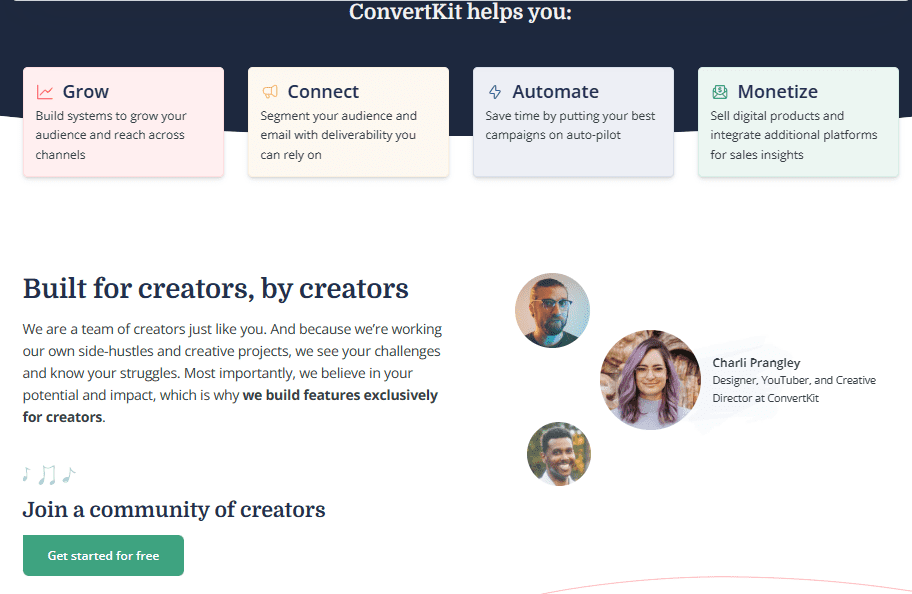

On the other hand, Leadpages is a landing page builder and lead generation software. It allows users to create high-converting landing pages, pop-ups, and alert bars without coding or design skills. Landing page conversion rates can be improved with the help of Leadpages’ extensive collection of editable templates and features like A/B testing and statistics. It also integrates with various email marketing and CRM platforms, enabling you to capture and nurture leads effectively.
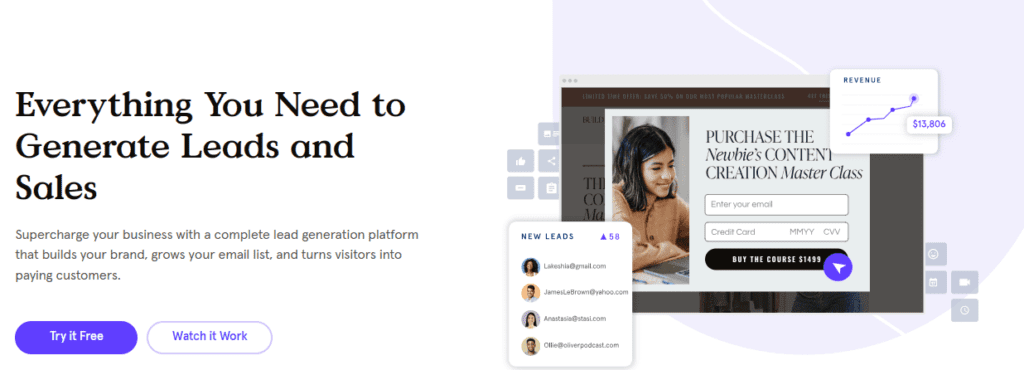

While ConvertKit primarily focuses on email marketing, Leadpages creates visually appealing and optimized landing pages to capture leads. Both platforms serve different purposes but can be complementary to your marketing strategy.
Key Features Detailed Comparison: Convertkit Vs Leadpages
User Interface:
Convertkit:
- Clean and Minimalistic Design: ConvertKit features a clean and minimalistic user interface. The design is focused on simplicity and ease of use, with a straightforward layout that prioritizes functionality over flashy visuals.
- Navigation and Menu Structure: ConvertKit offers a simple and intuitive navigation system. The main menu is located on the left side of the dashboard, providing easy access to essential features like broadcasts, automation, forms, and subscribers. The organization of the menu helps users find the desired functionality quickly.
- Email Workflow Overview: You can set up and handle email automation sequences with ConvertKit’s visual workflow editor. The interface provides a clear overview of your email sequences, including triggers, actions, and conditions, making it easy to understand and modify your email workflows.
Leadpages:
- Intuitive Drag-and-Drop Builder: Leadpages offers a user-friendly, drag-and-drop landing page builder. The interface allows you to easily add and customize elements like text, images, videos, forms, and buttons. You can rearrange elements and customize their properties with a few clicks.
- Template Selection and Customization: Leadpages provides pre-designed landing page templates, pop-ups, and alert bars. The template selection interface allows you to browse and preview different options. Once you select a template, you can customize it using intuitive editing options, including text editing, image replacement, and color adjustments.
- Dashboard and Analytics: Leadpages provides a comprehensive dashboard that displays analytics and insights about your landing page’s performance. You can view metrics like conversion rates, traffic sources, and A/B test results. The analytics interface helps you monitor the effectiveness of your campaigns and make data-driven decisions.
In this portion of our Convertkit vs Leadpages guide, we learned that both platforms offer user-friendly interfaces but with different focuses. ConvertKit’s interface is streamlined and optimized for managing email marketing, while Leadpages’ interface emphasizes intuitive drag-and-drop page building and analytics.
Landing Page Builder:
Convertkit:
- Simple Landing Page Builder: ConvertKit offers basic drag-and-drop landing page builders to create simple, responsive landing pages. The builder provides a user-friendly interface with pre-designed templates and drag-and-drop functionality for adding page elements.
- Limited Customization Options: While ConvertKit’s landing page builder is easy to use, it has more limited customization options than some dedicated landing page builders.
- Focus on Minimalistic Design: ConvertKit’s landing pages emphasize a clean, minimalistic design aesthetic. The templates and elements provided are optimized for simplicity and clarity, aiming to focus on capturing leads effectively rather than complex visual design.
Leadpages:
- Extensive Landing Page Builder: Leadpages provides a robust landing page builder with many customization options. You can select from many professional templates or start from scratch with a clean canvas. The builder offers drag-and-drop functionality, allowing you to add and rearrange elements on your pages easily.
- Advanced Customization Features: Leadpages offers advanced customization features such as custom CSS editing, dynamic text replacement, and HTML editing. These capabilities give you more flexibility and control over the design and functionality of your landing pages.
- Conversion-Optimized Templates: Leadpages provides a comprehensive collection of conversion-optimized templates designed to maximize lead generation and conversion rates. The professionally designed templates often include specific elements and layouts proven to drive results.
- A/B Testing and Conversion Analytics: Leadpages has an A/B testing feature that lets you make and test different versions of your landing pages to determine which ones work best in style and content. The platform also gives you full conversion analytics to track and analyze how well your landing pages are doing and make changes to make them work better.


ConvertKit’s landing page builder offers a straightforward way to create basic landing pages with a focus on minimalistic design. Leadpages, on the other hand, provides a more robust landing page builder with extensive customization options, conversion-optimized templates, A/B testing capabilities, and in-depth analytics. Leadpages offer more advanced customization features and optimization capabilities for your landing pages.
Pro Tip:
Time is an extremely valuable resource. Engage a highly experienced Leadpages specialist to develop your landing page if you want to skyrocket your business. Concentrate on the strategic aspects of the business.
Email Marketing:
Convertkit:
- Native Email Integration: ConvertKit is primarily an email marketing platform offering seamless integration with its own email system. This means that when you capture leads through ConvertKit forms or landing pages, they are automatically added to your ConvertKit subscriber list, making it easy to manage and communicate with your subscribers within the platform.
- Third-Party Email Integration: ConvertKit provides integration options with other email marketing platforms. It supports integration with popular email service providers such as Mailchimp, AWeber, Constant Contact, and more. This lets you connect ConvertKit with your existing email marketing tools and systems, ensuring smooth data transfer and synchronization.
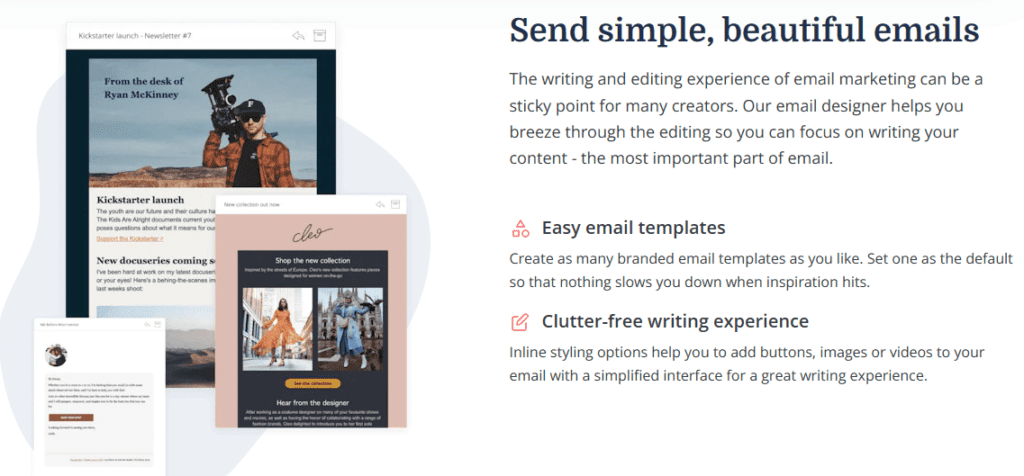

Pro Tip:
Time is a precious resource. If you want to accelerate your business, obtain the services of a highly experienced Convertkit expert to create your email marketing campaign, complete with a landing page, thank you page, and email sequence. Concentrate on the business’s strategic components.
Leadpages:
- Third-Party Email Integration: Leadpages offers extensive integration options with various third-party email marketing services. It integrates with popular platforms such as Mailchimp, AWeber, GetResponse, ActiveCampaign, and others. This feature enables you to seamlessly connect Leadpages with your preferred email marketing tool and synchronize your leads and subscriber data.
- Custom Form Actions: Leadpages allows you to set up custom form actions. You can integrate your forms with virtually any email marketing system that provides an API or HTML form integration. This attribute allows you to connect Leadpages with email service providers that may not have a native integration available.
ConvertKit and Leadpages offer email integration capabilities but with some differences. ConvertKit has its native email integration, making managing subscribers within the platform easy. It also supports integration with other popular email marketing tools. Leadpages, however, allows you to connect with your favorite email system by offering broad connection possibilities with a wide selection of 3rd-party email marketing platforms. Take note that these integrations mean added cost and may slow down the system.
Integration:
Convertkit:
- E-commerce Integrations: ConvertKit works seamlessly with e-commerce platforms like Shopify and WooCommerce. You can easily link your online store with ConvertKit and take your email marketing to the next level. With these integrations, you can send personalized and targeted emails based on customer behavior, purchase history, and other e-commerce data. If you want to grow your online business with Shopify and ConvertKit, click here to get started.


- Zapier Integration: ConvertKit has built-in integration with Zapier, which provides connectivity to hundreds of other applications and services. This allows you to create automated workflows and connect ConvertKit with several tools and platforms.
Leadpages:
- CRM Integrations: Leadpages integrates with powerful customer relationship management (CRM) systems like Salesforce and HubSpot. You can easily sync your lead data from Leadpages to your CRM, ensuring effective lead management and follow-up. If you want to boost your sales and marketing with Leadpages and HubSpot, explore here to get started.
- Webinar Integrations: Leadpages provides integrations with webinar platforms like GoToWebinar and Zoom. This allows you to seamlessly register and capture leads through your Leadpages forms and funnel them directly into your webinar software.
- Payment Gateway Integrations: Leadpages integrates with various payment gateways like Stripe and PayPal, enabling you to collect payments directly on your landing pages. This is particularly useful for selling products, services, or event tickets through Leadpages.
ConvertKit and Leadpages help me in various integrations to connect with other tools and platforms. ConvertKit focuses on email marketing and e-commerce integrations and has built-in integration with Zapier. Leadpages offers integrations with email marketing services, CRM systems, webinar platforms, and payment gateways.
Automation:
ConvertKit and Leadpages offer automation features that allow you to create automated workflows to send emails, collect leads, and more. However, there are some key differences between the two platforms.
Convertkit:
- Visual automation: ConvertKit’s automation is visual, making it easy to create and understand. You can drag and drop various actions to create your workflow and see a preview of your workflow as you create it.
- Conditional logic: ConvertKit’s automation allows you to use conditional logic, which means you can create different paths for your leads based on their actions or characteristics. For example, you could create a workflow that sends a different email to leads who sign up for your email list from different countries.
- Integrations: ConvertKit integrates with various other tools and services, so you can use your automation to connect with your CRM, marketing platform, and other apps.
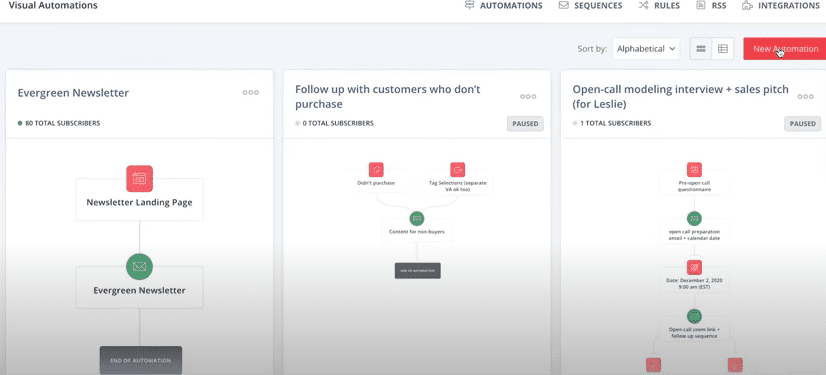

Leadpages:
- Simpler automation: Leadpages’ automations are simpler than ConvertKit’s, but they can still be effective. You can create automation based on triggers, such as when a lead signs up for your email list or makes a purchase.
- Drag-and-drop builder: Leadpages’ automation builder is drag-and-drop, which makes it easy to create your automation.
- Limited conditional logic: Leadpages’ automation does not offer as much conditional logic as ConvertKit’s. However, you can still create different paths for your leads based on their actions or characteristics.
- Limited integrations: Leadpages integrates with fewer tools and services than ConvertKit.
Ultimately, the best automation features for you will depend on your specific needs and requirements. If you need a simple and easy-to-use automation platform, Leadpages is a good option. If you need a more powerful and flexible automation platform, ConvertKit is a better choice.
Customization:
Convertkit:
- Email Template Customization: ConvertKit provides a range of customizable email templates. While the customization options are not as extensive as other email marketing platforms, you can modify the text, colors, and basic formatting to align with your branding.
- Form Customization: ConvertKit allows you to customize the appearance and fields of your opt-in forms. You can modify the form design, add or remove fields, and customize the text and call-to-action buttons.
- Landing Page Customization: ConvertKit provides a basic landing page builder with limited customization options. You can pick from templates already made and change the text, pictures, and colors.
Leadpages:
- Landing Page Customization: Leadpages offers a robust landing page builder with extensive customization options. You can select from numerous pre-designed templates and customize them to fit your branding and design preferences. Using an intuitive drag-and-drop editor, you can modify text, images, videos, buttons, and other elements.
- Pop-up and Alert Bar Customization: Leadpages allows you to customize the design and behavior of pop-ups and alert bars. You can choose templates and modify text, colors, animations, and triggers.
- Template Editing: Leadpages offers more advanced editing options where you can edit templates at a code level, allowing you to make more intricate customizations to the design and functionality of your landing pages.
In this section of our Convertkit vs Leadpages review, we determined that ConvertKit offers customization options for email templates and opt-in forms, but its landing page customization capabilities are more limited than Leadpages. Leadpages provides comprehensive customization features, allowing you to extensively customize landing pages, pop-ups, and alert bars to match your brand and design preferences.
A/B Testing:
Convertkit:
- Email A/B Testing: ConvertKit offers A/B testing for email broadcasts. You can create multiple versions of your email and test variables such as subject lines, email content, or call-to-action buttons. ConvertKit provides a straightforward interface to set up and monitor A/B tests. However, it’s important to note that A/B testing is currently only available for email broadcasts and not for automated email sequences.
- Simple A/B Test Reporting: ConvertKit provides basic reporting on A/B tests, showing the performance metrics of each test variant. You can view statistics such as open rates, click-through rates, and conversion rates to help you identify the winning version. While informative, the reporting may offer less granularity or advanced analysis than dedicated A/B testing tools.
Leadpages:
- Landing Page A/B Testing: Leadpages offers A/B testing functionality specifically for landing pages. You may improve your landing page’s conversion rate by creating multiple versions and comparing them. Leadpages provides an intuitive interface to set up and manage A/B tests for landing pages.
- Comprehensive A/B Test Reporting: Leadpages provides detailed reporting on A/B tests, allowing you to analyze the performance of each test variant. You can view conversion rates, traffic sources, engagement, and other key performance indicators. The comprehensive reporting helps you make data-driven decisions and optimize your landing pages for better results.
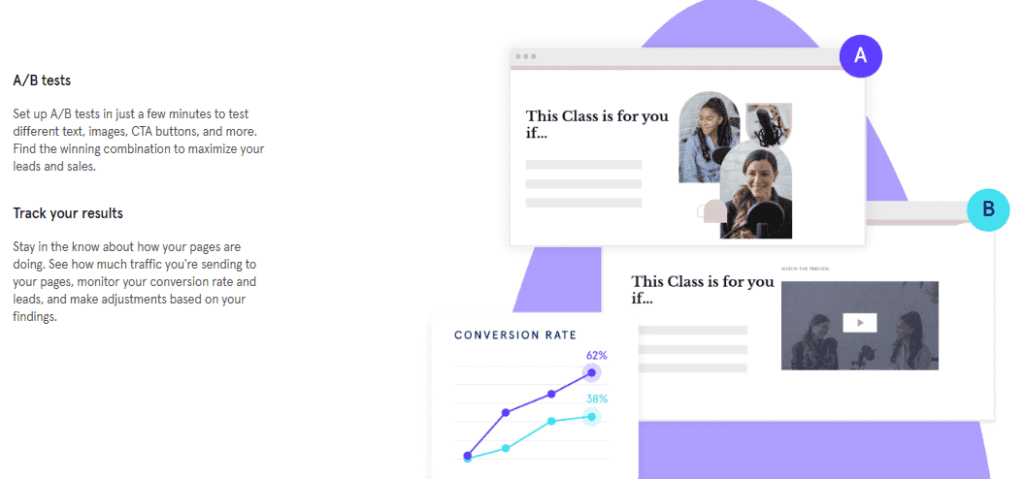

ConvertKit offers A/B testing specifically for email broadcasts, while Leadpages provides A/B testing functionality for landing pages. ConvertKit’s A/B testing focuses more on email content and subject lines, while Leadpages’ A/B testing is centered around optimizing landing pages for higher conversion rates. We realized in this Convertkit vs Leadpages review that Leadpages provides more comprehensive reporting on A/B tests, giving you deeper insights into the performance of different variations.
Analytics And Reporting:
Convertkit:
- Email Analytics: With ConvertKit, you can access reliable analytics for your email campaigns, such as open rates, click-through rates, and unsubscribe rates. You can monitor the performance of your email broadcasts and automated sequences to measure the engagement level of your audience and the effectiveness of your strategies.
- Subscriber Analytics: ConvertKit also provides insights into subscriber behavior and engagement. You can view data on subscriber growth, segment performance, and individual subscriber activity. This information helps you understand your audience better and make informed decisions regarding content targeting and segmentation.
- Simple Reporting Interface: ConvertKit’s reporting interface is straightforward and user-friendly. It presents data in a clear and easy-to-understand format, making it accessible to users with varying levels of technical expertise.
Leadpages:
- Landing Page Analytics: Leadpages provides trustworthy analytics for landing pages. You can measure conversion rates, page views, click-through rates, and bounce rates. The analytics reveal the performance of your landing pages, enabling you to detect areas for enhancement and refine your campaigns.
- Traffic Sources and Referral Data: Leadpages inform you about where your visitors are coming from and which sources lead to the most conversions. This data can help you allocate resources effectively and focus on the most successful marketing channels.
- A/B Test Reporting: Leadpages offers detailed reporting on A/B tests, showing the performance of different variations of your landing pages. You can analyze conversion rates, engagement, and other relevant metrics to identify the winning version and make data-driven decisions for optimization.
Based on my experience, ConvertKit delivers email-focused analytics and reporting, highlighting email campaign performance and subscriber engagement. Leadpages provides reliable analytics for landing pages, covering conversion rates, traffic sources, and A/B test reporting. Leadpages’ analytics help you gain a deeper insight into your landing page performance and empower you to optimize your campaigns efficiently.
Lead Capture and Opt-in Forms:
Convertkit:
- Customizable Opt-in Forms: ConvertKit allows you to create and customize opt-in forms to capture leads. You can select from various form types, including inline forms, modal pop-ups, and slide-ins. The forms are customizable in design, fields, and messaging, allowing you to align them with your brand and capture the necessary information.
- Tag-Based Opt-in Segmentation: ConvertKit’s opt-in forms are integrated with its tagging system. This means you can assign specific tags to subscribers based on the opt-in form they used, enabling you to segment your audience and deliver targeted email marketing campaigns.
- Advanced Opt-in Form Triggers: ConvertKit provides advanced trigger options for opt-in forms, allowing you to display forms based on user behavior and engagement. You can set triggers such as exit intent, time-delayed, scroll percentage, and more to optimize the timing and visibility of your opt-in forms.
Leadpages:
- Extensive Opt-in Form Library: Leadpages offers a wide range of pre-designed opt-in form templates that you can choose from and customize. The themes are made to look good and get people to take action, which helps you get more leads.
- A/B Testing of Opt-in Forms: Leadpages provides A/B testing functionality specifically for opt-in forms. You can create different variations of your forms and test them against each other to determine which design and messaging generate the best conversion rates.
- Multiple Opt-in Form Integration Options: Leadpages integrates with various email marketing services, allowing you to connect your opt-in forms directly to your preferred email marketing tool.
- Exit Intent and Trigger Options: Leadpages offers exit-intent technology for opt-in forms, enabling you to display a form when a visitor is about to leave your website. Additionally, Leadpages provides trigger options like time-delayed, scroll-based, and click-triggered forms, allowing you to control when and how the opt-in forms appear.
ConvertKit’s opt-in forms are integrated with its tagging system, enabling segmentation, while Leadpages provides a more extensive library of pre-designed templates and A/B testing functionality. Leadpages offers more advanced trigger options, such as exit-intent and time-delayed forms.
Customer Support:
Convertkit:
- Knowledge Base: ConvertKit offers a comprehensive knowledge base that contains helpful articles, tutorials, and guides to assist users in understanding and utilizing the platform’s features.
- Email Support: ConvertKit provides email support for users to contact their support team directly with any questions or issues. Users can submit support tickets through the ConvertKit website and expect a response within a reasonable timeframe.
- Live Workshops and Training: ConvertKit regularly conducts live workshops and training sessions to educate users about their platform’s features and provide insights into email marketing strategies.
Leadpages:
- Knowledge Base and Community: Leadpages offers a comprehensive knowledge base that includes articles, tutorials, and videos to help users navigate the platform and troubleshoot issues. Additionally, Leadpages has an active community forum where users can interact, ask questions, and share experiences.
- Email and Chat Support: Leadpages provides email and chat support to assist users with inquiries. Users can submit support tickets through the Leadpages website and communicate directly with the support team via email or live chat.
- Phone Support: Leadpages offers phone support for users on their Pro and Advanced plans. This allows users to speak directly with a support representative for more immediate assistance with their inquiries or technical issues.
ConvertKit and Leadpages offer customer service through their knowledge bases, email support channels, and resources for self-help. Leadpages additionally provides a community forum for users to engage with each other. ConvertKit offers live workshops and training sessions, while Leadpages includes user phone support on specific plans.
Target Market:
Convertkit:
ConvertKit primarily caters to the needs of content creators, bloggers, and small businesses. It focuses on providing email marketing and automation tools designed explicitly for creators who want to build and nurture their audience through valuable content. ConvertKit’s features and functionality are tailored to the requirements of individuals and small teams who prioritize content marketing, audience engagement, and building relationships with their subscribers.
It is particularly popular among bloggers, podcasters, authors, online course creators, and other digital content creators who rely on email marketing as a primary channel for communication and monetization.
Leadpages:
Leadpages is designed to serve a broader market, including small and medium-sized businesses (SMBs), marketing agencies, and entrepreneurs. It caters to individuals and teams who need to create high-converting landing pages and lead capture forms to generate leads and drive conversions.
Leadpages provides a comprehensive suite of tools beyond email marketing, focusing on landing page optimization, A/B testing, lead generation, and conversion rate optimization. Its features and functionality are well-suited for marketers, business owners, and marketing agencies seeking to maximize their online lead generation and sales efforts.
ConvertKit’s target market is content creators and small businesses prioritizing email marketing and audience engagement. Leadpages, on the other hand, serve a broader market of SMBs, marketers, and entrepreneurs looking to optimize their lead generation, landing pages, and conversion rates.
Uniques Features of Convertkit:
Unique Features of Leadpages:
Convertkit Pricing Plans:
| Features | Free | Creator | Creator Pro |
| Price | Free | $15/mo | $29/mo |
| Contacts | 1,000 | 300 | 300 |
| Landing pages | Unlimited | Unlimited | Unlimited |
| Forms | Unlimited | Unlimited | Unlimited |
| Broadcast | Unlimited | Unlimited | Unlimited |
| Tagging & Segmentation |                                                                    |                                                                    |                                                                    |
| Sell Digital Products & Subscriptions |                                                                    |                                                                    |                                                                    |
| Opt-in incentives |                                                                    |                                                                    |                                                                    |
| FB custom audience |                         |                         |                                                                    |
| Creator network |                         |                                                                    |                                                                    |
| Email template library |                                                                    |                                                                    |                                                                    |
| Conditional email content |                                                                    |                                                                    |                                                                    |
| Deliverability reporting |                         |                         |                                                                    |
| API Documentation |                                                                    |                                                                    |                                                                    |
| Visual automation builder |                         |                                                                    |                                                                    |
| Automated email sequence |                         |                                                                    |                                                                    |
| 70+ direct integrations |                         |                                                                    |                                                                    |
| Customer support | Community support | Live chat/email support | Priority live chat/email support |


Leadpages Pricing Plan:
| Features | Standard | Pro |
| Price | $49/mo | $99/mo |
| Drag & Drop Landing Page Builder |                                                                    |                                                                    |
| Ai Engine Credits | 10,000/mo | 30,000/mo |
| Ai Engine Headlines + Images |                                                                    |                                                                    |
| Conversion tools |                                                                    |                                                                    |
| Optimized templates | 250+ | 250+ |
| Traffic & Leads | Unlimited | Unlimited |
| Custom domains | 1 | 3 |
| Integrations | 90+ | 90+ |
| E-commerce |                         |                                                                    |
| Tech support |                                                                    |                                                                    |
| Mobile responsive templates |                                                                    |                                                                    |
| Landing pages, pop-ups, and alert bars | Unlimited | Unlimited |
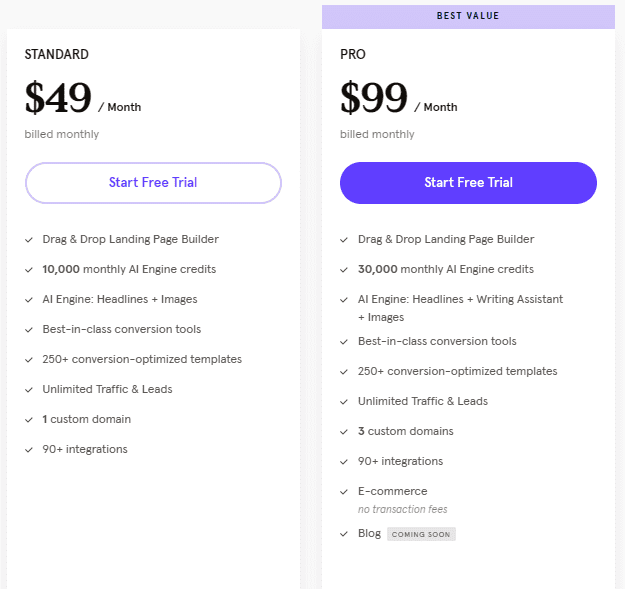

Pros and Cons:
Convertkit Pros:
Convertkit Cons:
Leadpages Pros:
Leadpages Cons:
Final Thoughts/Recommendations:
ConvertKit and Leadpages are powerful platforms offering unique features and functionalities to support your online marketing efforts. ConvertKit focuses primarily on email marketing automation, targeting content creators and small businesses that prioritize audience engagement. Leadpages, on the other hand, offers a comprehensive suite of tools for landing page optimization, lead generation, and conversion rate optimization, targeting a broader range of small business owners, medium-sized businesses, marketers, and entrepreneurs.
When choosing between ConvertKit and Leadpages, consider your specific needs and priorities. Suppose you heavily rely on content marketing and email communication to nurture and engage your audience. ConvertKit’s user-friendly interface, email marketing-centric features, and simplicity may be the right fit for you. It suits bloggers, podcasters, authors, and similar content creators.
However, Leadpages provides a more all-encompassing solution in terms of tools for landing page optimization, A/B testing, and lead generation. It offers advanced customization options, conversion-optimized templates, and additional tools to maximize your lead-generation efforts. Leadpages is well-suited for small and medium-sized businesses, marketers, and entrepreneurs seeking to optimize their online lead generation and landing page.
It’s also worth considering factors such as pricing, scalability, integrations with other tools, and the level of customer support provided. Take advantage of both platforms’ free trials and demos to get hands-on experience and determine which platform aligns best with your specific goals and requirements.
Recommendations:
Related Articles:
Notes:
- The price is based on 300 contacts.
- Reference: Trustpilot Rating










One Comment